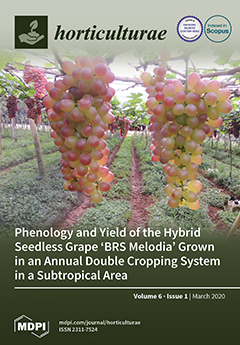Aquaponics is a rapidly growing food-production system integrating aquaculture and hydroponic crop production through an energy-intensive water recirculation process. Crop performance and yield in aquaponics are affected by essential and toxic nutrient levels in the root zone, which can be regulated by water flow rate. This study was conducted to examine the effects of hydraulic loading rate (HLR) on water quality and crop growth and yield in recirculating aquaponic systems set at three different loading rates: high (3.3 m
3/m
2/day; HFR, which is 12 times lower than recommended loading rate), medium (2.2 m
3/m
2/day; MFR), and low (1.1 m
3/m
2/day; LFR). Crop species varying in growth rate were examined for their optimal HLR: fast-growing Chinese cabbage (
Brassica rapa) and lettuce (
Lactuca sativa); medium-growing mustard (
Brassica juncea) and chia (
Salvia hispanica); and slow-growing basil (
Ocimum basilicum) and Swiss chard (
Beta vulgaris). Compared to LFR, HFR decreased water and leaf temperatures and total ammonium nitrogen (TAN) but increased dissolved oxygen and pH in aquaponic solution up to one and two weeks after transplant, respectively. HFR increased NO
3–N concentration by 50 and 80%, respectively, compared to MFR and LFR, while reducing the exposure duration of roots to ammonia (NH
3–N) and its peak concentration through rapid dissipation of the toxic compound. Lower electrical conductivity (EC) in HFR during the last two weeks of production was associated with higher plant nutrient uptake and greater biomass production. The leaf greenness, photosynthetic rate (
Pn), and total plant N were significantly higher at HFR than LFR. Fish growth rate, fresh weight, and feed-conversion efficiency were also increased by HFR. The growth of fast-growing crops including total fresh weight, shoot fresh weight, leaf area, and
Pn was not different between HFR and MFR, while HLR had less significant effects on the growth and performance (i.e., shoot fresh weight and whole plant photosynthesis) of slow-growing crops. In conclusion, the flow rate is an important component in aquaponic crop production as it affects spatial and temporal water characteristics and subsequently determines the growth and yield of the crops. HLR at 3.3 m
3/m
2/day was sufficient across the crops allowing better chemical and physical properties of the aquaponic solution for maximum yield and quality. HLR should be maintained at least at 2.2 m
3/m
2/day for the production of fast-growing crops but can be lowered for slow-growing crops.
Full article





